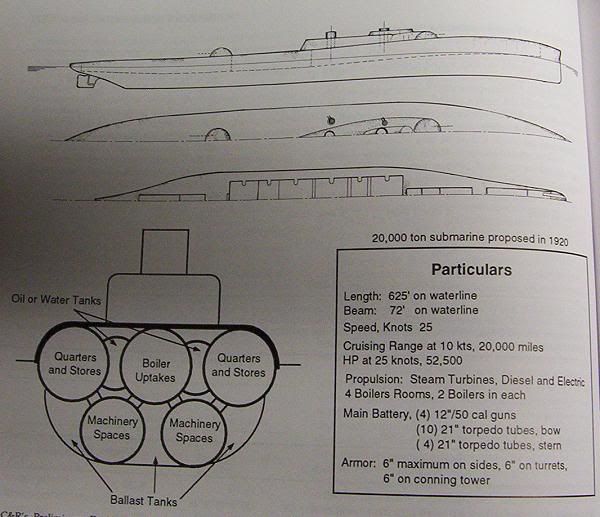I found this little monster in the submarine board of the old Warships1.com. I though she´d be worth a try, and I simmed her. So what do you think about her? can you imagine these little ones serving in WW2? Perhaps converted into a submarine aircraft carrier? Just wondering... She´s from Norman Friedman's "US Submarines Through 1945: An Illustrated Design History".

20000 ton, Submarine Cruiser laid down 1920
Displacement:
19.272 t light; 20.000 t standard; 22.000 t normal; 23.511 t full load
Dimensions: Length overall / water x beam x draught
625,01 ft / 625,00 ft x 72,00 ft x 40,74 ft (normal load)
190,50 m / 190,50 m x 21,95 m x 12,42 m
Armament:
4 - 12,00" / 305 mm guns (2x2 guns), 864,00lbs / 391,90kg shells, 1920 Model
Breech loading guns in turrets (on barbettes)
on centreline ends, evenly spread
Weight of broadside 3.456 lbs / 1.568 kg
Shells per gun, main battery: 150
14 - 21,0" / 533,4 mm submerged torpedo tubes
Armour:
- Belts: Width (max) Length (avg) Height (avg)
Main: 6,00" / 152 mm 305,00 ft / 92,96 m 10,00 ft / 3,05 m
Ends: Unarmoured
Main Belt covers 75 % of normal length
- Gun armour: Face (max) Other gunhouse (avg) Barbette/hoist (max)
Main: 6,00" / 152 mm 1,00" / 25 mm 2,00" / 51 mm
- Conning tower: 6,00" / 152 mm
Machinery:
Oil fired boilers, steam turbines plus diesel motors,
Electric cruising motors plus geared drives, 4 shafts, 51.730 shp / 38.591 Kw = 25,00 kts
Range 20.000nm at 10,00 kts (Bunkerage = 3.599 tons)
Complement:
903 - 1.174
Cost:
£3,051 million / $12,202 million
Distribution of weights at normal displacement:
Armament: 432 tons, 2,0 %
Armour: 1.011 tons, 4,6 %
- Belts: 810 tons, 3,7 %
- Torpedo bulkhead: 0 tons, 0,0 %
- Armament: 99 tons, 0,5 %
- Armour Deck: 0 tons, 0,0 %
- Conning Tower: 102 tons, 0,5 %
Machinery: 1.809 tons, 8,2 %
Hull, fittings & equipment: 11.520 tons, 52,4 %
Fuel, ammunition & stores: 2.728 tons, 12,4 %
Miscellaneous weights: 4.500 tons, 20,5 %
Overall survivability and seakeeping ability:
Survivability (Non-critical penetrating hits needed to sink ship):
14.917 lbs / 6.766 Kg = 17,3 x 12,0 " / 305 mm shells or 2,2 torpedoes
Stability (Unstable if below 1.00): 1,02
Metacentric height 3,2 ft / 1,0 m
Steadiness - As gun platform (Average = 50 %): 0 %
- Recoil effect (Restricted arc if above 1.00): 0,00
Seaboat quality (Average = 1.00): 0,00
Hull form characteristics:
Hull has a flush deck
Block coefficient: 0,420
Length to Beam Ratio: 8,68 : 1
'Natural speed' for length: 25,00 kts
Power going to wave formation at top speed: 41 %
Trim (Max stability = 0, Max steadiness = 100): 50
Bow angle (Positive = bow angles forward): 5,00 degrees
Stern overhang: 0,00 ft / 0,00 m
Freeboard (% = measuring location as a percentage of overall length):
- Stem: 0,10 ft / 0,03 m
- Forecastle (30 %): 0,10 ft / 0,03 m
- Mid (50 %): 0,10 ft / 0,03 m
- Quarterdeck (15 %): 0,10 ft / 0,03 m
- Stern: 0,10 ft / 0,03 m
- Average freeboard: 0,10 ft / 0,03 m
Ship tends to be wet forward
Ship space, strength and comments:
Space - Hull below water (magazines/engines, low = better): 74,6 %
- Above water (accommodation/working, high = better): 0,6 %
Waterplane Area: 26.601 Square feet or 2.471 Square metres
Displacement factor (Displacement / loading): 175 %
Structure weight / hull surface area: 290 lbs/sq ft or 1.417 Kg/sq metre
Hull strength (Relative):
- Cross-sectional: 2,58
- Longitudinal: 1,83
- Overall: 2,00
Hull space for machinery, storage, compartmentation is excellent
Room for accommodation and workspaces is extremely poor
Ship has quick, lively roll, not a steady gun platform
Caution: Lacks seaworthiness - very limited seakeeping ability

